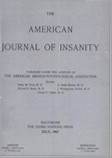THE APPRAISAL OF INTELLECTUAL AND PHYSICAL FACTORS AFTER CEREBRAL DAMAGE IN CHILDREN
Abstract
Obviously we do not present these cases with any feeling that they settle anything, but merely to indicate a method of appraisal which seems to us worth while. In the first place, we have come to the conclusion, which is, of course, nothing new, that accurate psychological study is just as likely to indicate the existence and the extent of cerebral injury in childhood as is physical examination.
Second, considerable defects of brain tissue can exist with minimal physical and psychological changes. On the whole, we are reasonably sure that encephalography is a tool which can be intelligently used in many dubious cases where decisions are important.
Third, it is our impression from the observation of cases of this sort over a number of years, that the period of convalescence is frequently prolonged, so that it is quite possible to subject the convalescent child to stresses which are harmful.
We have no data which suggest that there is any direct correlation between the severity of the injury as demonstrated by encephalography and the disorder of behavior. On the whole we are inclined to believe that gross evidence of cerebral damage is hard to collect in the typical "post-encephalitic" and "post-traumatic" behavior disorders.
It is suggested, more for the purposes of argument than as a statement of fact, that the children whose brains are grossly damaged are protected during convalescence by the very nature of their disabilities, while the less obvious lesions do not produce symptoms which lead to protection.
Access content
To read the fulltext, please use one of the options below to sign in or purchase access.- Personal login
- Institutional Login
- Sign in via OpenAthens
- Register for access
-
Please login/register if you wish to pair your device and check access availability.
Not a subscriber?
PsychiatryOnline subscription options offer access to the DSM-5 library, books, journals, CME, and patient resources. This all-in-one virtual library provides psychiatrists and mental health professionals with key resources for diagnosis, treatment, research, and professional development.
Need more help? PsychiatryOnline Customer Service may be reached by emailing [email protected] or by calling 800-368-5777 (in the U.S.) or 703-907-7322 (outside the U.S.).



